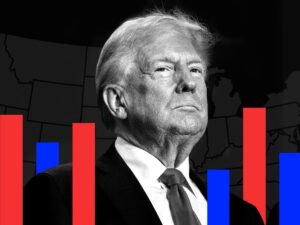It’s been a rollercoaster week for the stock market as investors grapple with the possibility of a December rate cut. The market’s post-Trump-election rally has been erased bit by bit, with major US indexes selling off sharply.
The turning point came when Federal Reserve Chair Jerome Powell announced that the central bank will not rush into cutting rates, citing positive economic signals. This news, coupled with a string of strong economic data, has led investors to question whether a rate cut in December is necessary.
As a result, major US indexes saw significant declines, with the S&P 500 falling as much as 1.6% and the Nasdaq dropping 2.7% at intraday lows. The S&P 500 lost 2.2% for the week, while the Dow Jones industrial average and the Nasdaq fell 1.2% and 3.2%, respectively.
The market’s losses are reflected in the decreasing odds of a rate cut in December, with investors now pricing in a 58% probability, down from around 80% before Powell’s announcement. This shift in sentiment has been further fueled by promising US economic data, including strength in retail sales and lower-than-expected jobless claims.
Investors are also considering the potential impact of Trump’s policies on the market, particularly his trade policies and their potential to drive inflation higher. While initially focused on tax cuts and deregulation, investors are now factoring in the uncertainty introduced by Powell’s cautious stance on rate cuts.
As the market continues to adjust to this new information, it’s crucial for investors to stay informed and prepared for further developments. In a volatile market environment, being informed and proactive can make all the difference in maximizing returns and minimizing risks. Stay tuned for more updates on the market and how to navigate it effectively.

